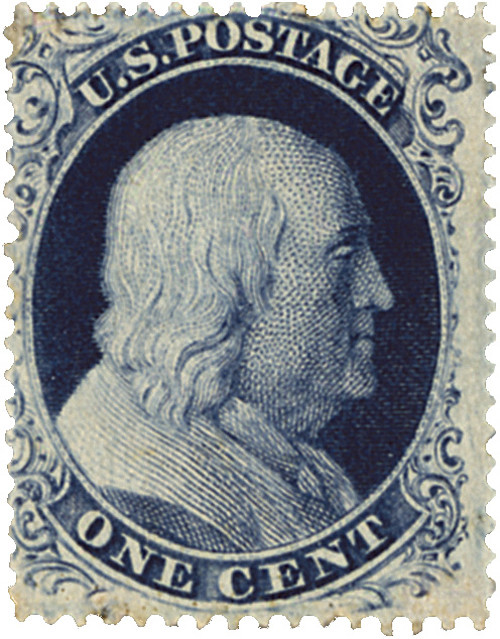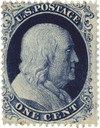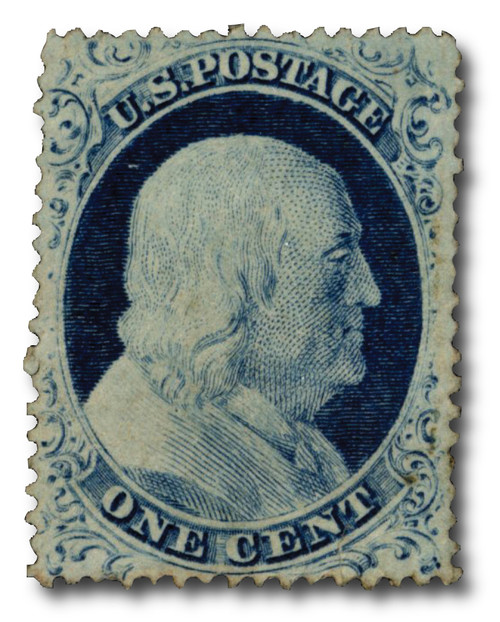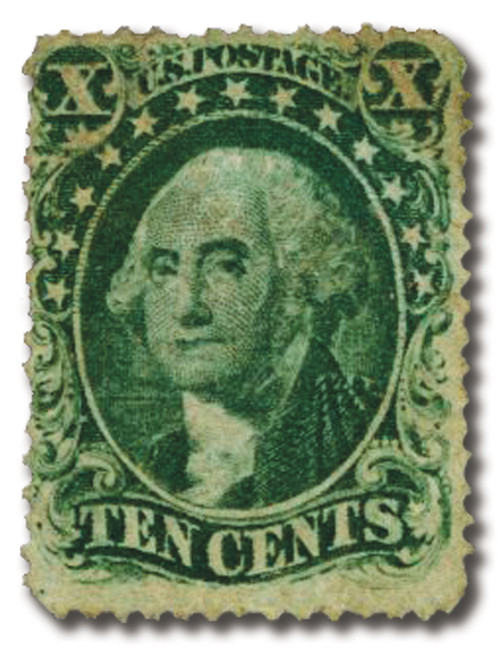
# 22 - 1857-61 1c Franklin, type IIIA
U.S. #22
1857 1c Franklin, Type IIIa
- First perforated postage stamp in US history
Stamp Category: Definitive
Series: 1857-61 Issue
Value: 1c
Issue date: 1857
Earliest documented use: July 26, 1857
Quantity Issued: Unknown
Printed by: Toppan, Carpenter & Co.
Format: Sheets of 200 stamps divided into two panes of 100 each, arranged in rows of ten.
Printing Method: Engraving
Perforations: 15½
Color: Blue
Why the stamp was issued: The 1c denomination was issued to pay the first-class rate for newspapers, drop letters, and unsealed circulars.
About the printing: Several of the stamps from this issue look similar, but are different “types.” Types or “varieties” occur when a stamp has differences from the way it was originally intended to be printed. These differences occur when the design is being transferred to the plate for printing or when lines are re-cut.
The design is engraved on a die – a small, flat, polished piece of steel. The design is copied to a transfer roll – a blank roll of steel. Several impressions or “reliefs” are made on the roll. The reliefs are transferred to the plate – a large, flat piece of steel from which the stamps are printed. A damaged plate or foreign matter can cause differences. Lines re-cut on a worn plate can result in double lines, called double transfers, as well as other variations.
Eight varieties of the 1c Franklin stamp were created as the engravers attempted to fit all the fancy scrollwork onto the plate and allow room for the perforations. Recutting the plates was done in order to fit the required number of stamps. With the recutting came various levels of completeness of some design elements: scrolls, scroll balls, plumes, and ornaments. This led to the typing of the 1c stamp according to what parts were complete versus incomplete.
About the stamp design: US #22 is Type IIIa. Either top and bottom outer frame line is broken. Scroll balls and bottoms of plumes are missing.
Special design details: Franklin’s image on the stamp is based on a sculpture of him by French artist Jean-Jacques Caffieri.
About the 1857-61 Series: The 1857-61 issues were the very first perforated U.S. stamps. Their designs were reproduced from the imperforate plates of 1851. Because the same plates were used, the perforate stamp types don’t differ much from the corresponding imperforate stamps. The entire series (U.S. #18-39) is noted for having narrow margins because it now had to accommodate the perforations. Some newer plates were created to allow for more space between the stamps.
Recutting the plates was done in order to make room for the required number of stamps. With the recutting came variations in the degree of completeness or even lack of some design elements, like scrolls or frame lines. Sometimes newer plates were created to allow for more space between the stamps, making for further variations. All these differences make collecting even more fun and interesting as eager philatelists look to see what’s in their collection or what they want to add to it.
History the stamp represents: When the world’s first postage stamps were released, no provision was made for separating the stamps from one another. Post office clerks and stamp users merely cut these “imperforates” apart with scissors or tore them along the edge of a metal ruler. A device was needed which would separate the stamps more easily and accurately.
In 1847, Irishman Henry Archer patented a machine that punched holes horizontally and vertically between rows of stamps. Now stamps could be separated without cutting. Perforations enabled stamps to adhere better to envelopes. He sold his invention to the British Treasury in 1853. That same year, Great Britain produced its first perforated stamps. The US followed with the Series of 1857-61.
Several of the stamps from this issue look similar, but are different “types.” Types or “varieties” occur when a stamp has differences from the way it was originally intended to be printed. These differences occur when the design is being transferred to the plate for printing or when lines are re-cut.
The design is engraved on a die – a small, flat, polished piece of steel. The design is copied to a transfer roll – a blank roll of steel. Several impressions or “reliefs” are made on the roll. The reliefs are transferred to the plate – a large, flat piece of steel from which the stamps are printed. A damaged plate or foreign matter can cause differences. Lines re-cut on a worn plate can result in double lines, called double transfers, as well as other variations.
Eight varieties of this stamp were created. Printing on handmade paper was harder to fit all the fancy scrollwork onto the plate than on machine-made paper, which was larger. Recutting the plates was done in order to fit the required number of stamps. With the recutting came various levels of completeness of some design elements: scrolls, scroll balls, plumes, and ornaments. This led to the typing of the stamps according to what parts were complete versus incomplete.
U.S. #22
1857 1c Franklin, Type IIIa
- First perforated postage stamp in US history
Stamp Category: Definitive
Series: 1857-61 Issue
Value: 1c
Issue date: 1857
Earliest documented use: July 26, 1857
Quantity Issued: Unknown
Printed by: Toppan, Carpenter & Co.
Format: Sheets of 200 stamps divided into two panes of 100 each, arranged in rows of ten.
Printing Method: Engraving
Perforations: 15½
Color: Blue
Why the stamp was issued: The 1c denomination was issued to pay the first-class rate for newspapers, drop letters, and unsealed circulars.
About the printing: Several of the stamps from this issue look similar, but are different “types.” Types or “varieties” occur when a stamp has differences from the way it was originally intended to be printed. These differences occur when the design is being transferred to the plate for printing or when lines are re-cut.
The design is engraved on a die – a small, flat, polished piece of steel. The design is copied to a transfer roll – a blank roll of steel. Several impressions or “reliefs” are made on the roll. The reliefs are transferred to the plate – a large, flat piece of steel from which the stamps are printed. A damaged plate or foreign matter can cause differences. Lines re-cut on a worn plate can result in double lines, called double transfers, as well as other variations.
Eight varieties of the 1c Franklin stamp were created as the engravers attempted to fit all the fancy scrollwork onto the plate and allow room for the perforations. Recutting the plates was done in order to fit the required number of stamps. With the recutting came various levels of completeness of some design elements: scrolls, scroll balls, plumes, and ornaments. This led to the typing of the 1c stamp according to what parts were complete versus incomplete.
About the stamp design: US #22 is Type IIIa. Either top and bottom outer frame line is broken. Scroll balls and bottoms of plumes are missing.
Special design details: Franklin’s image on the stamp is based on a sculpture of him by French artist Jean-Jacques Caffieri.
About the 1857-61 Series: The 1857-61 issues were the very first perforated U.S. stamps. Their designs were reproduced from the imperforate plates of 1851. Because the same plates were used, the perforate stamp types don’t differ much from the corresponding imperforate stamps. The entire series (U.S. #18-39) is noted for having narrow margins because it now had to accommodate the perforations. Some newer plates were created to allow for more space between the stamps.
Recutting the plates was done in order to make room for the required number of stamps. With the recutting came variations in the degree of completeness or even lack of some design elements, like scrolls or frame lines. Sometimes newer plates were created to allow for more space between the stamps, making for further variations. All these differences make collecting even more fun and interesting as eager philatelists look to see what’s in their collection or what they want to add to it.
History the stamp represents: When the world’s first postage stamps were released, no provision was made for separating the stamps from one another. Post office clerks and stamp users merely cut these “imperforates” apart with scissors or tore them along the edge of a metal ruler. A device was needed which would separate the stamps more easily and accurately.
In 1847, Irishman Henry Archer patented a machine that punched holes horizontally and vertically between rows of stamps. Now stamps could be separated without cutting. Perforations enabled stamps to adhere better to envelopes. He sold his invention to the British Treasury in 1853. That same year, Great Britain produced its first perforated stamps. The US followed with the Series of 1857-61.
Several of the stamps from this issue look similar, but are different “types.” Types or “varieties” occur when a stamp has differences from the way it was originally intended to be printed. These differences occur when the design is being transferred to the plate for printing or when lines are re-cut.
The design is engraved on a die – a small, flat, polished piece of steel. The design is copied to a transfer roll – a blank roll of steel. Several impressions or “reliefs” are made on the roll. The reliefs are transferred to the plate – a large, flat piece of steel from which the stamps are printed. A damaged plate or foreign matter can cause differences. Lines re-cut on a worn plate can result in double lines, called double transfers, as well as other variations.
Eight varieties of this stamp were created. Printing on handmade paper was harder to fit all the fancy scrollwork onto the plate than on machine-made paper, which was larger. Recutting the plates was done in order to fit the required number of stamps. With the recutting came various levels of completeness of some design elements: scrolls, scroll balls, plumes, and ornaments. This led to the typing of the stamps according to what parts were complete versus incomplete.
















